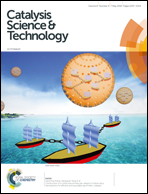Synergistic design for enhancing solar-to-hydrogen conversion over a TiO2-based ternary hybrid†
Abstract
Enhancing the visible light responsiveness and photoactivity of TiO2 is of strategic significance and is one of the hottest research frontiers. Traditional papers focus on extending the universality of each method with a series of different mechanisms, but only a few studies have discovered the huge importance of the synergistic enhancement effect when two or more conventional strategies are combined for one TiO2 nanoparticle. Herein, a ternary pizza-like BE–Au–TiO2 hybrid is deliberately designed based on a conjugated polymer (a modified poly(benzothiadiazole) flake, B-BT-1,4-E, denoted as BE) acting as a photosensitizer, Au nanoparticles serving as a surface plasmon resonance (SPR) source, and TiO2 for electron collection and as a H2 production medium. The mechanisms of sensitization and SPR-enhancement can be combined together to overcome the drawbacks of insufficient electron separation and transfer, and significantly improve the internal electron transfer efficiency over each mono-mechanism. Finally, the visible light-driven H2 production rate of the BE–Au–TiO2 hybrid is ∼1.9 and ∼68 times faster than that of BE–TiO2 and Au–TiO2, respectively, and a high AQY of 7.8% at 420 nm is obtained. This work opens a new window leading to the design of highly efficient photocatalytic H2 production performance.



 Please wait while we load your content...
Please wait while we load your content...